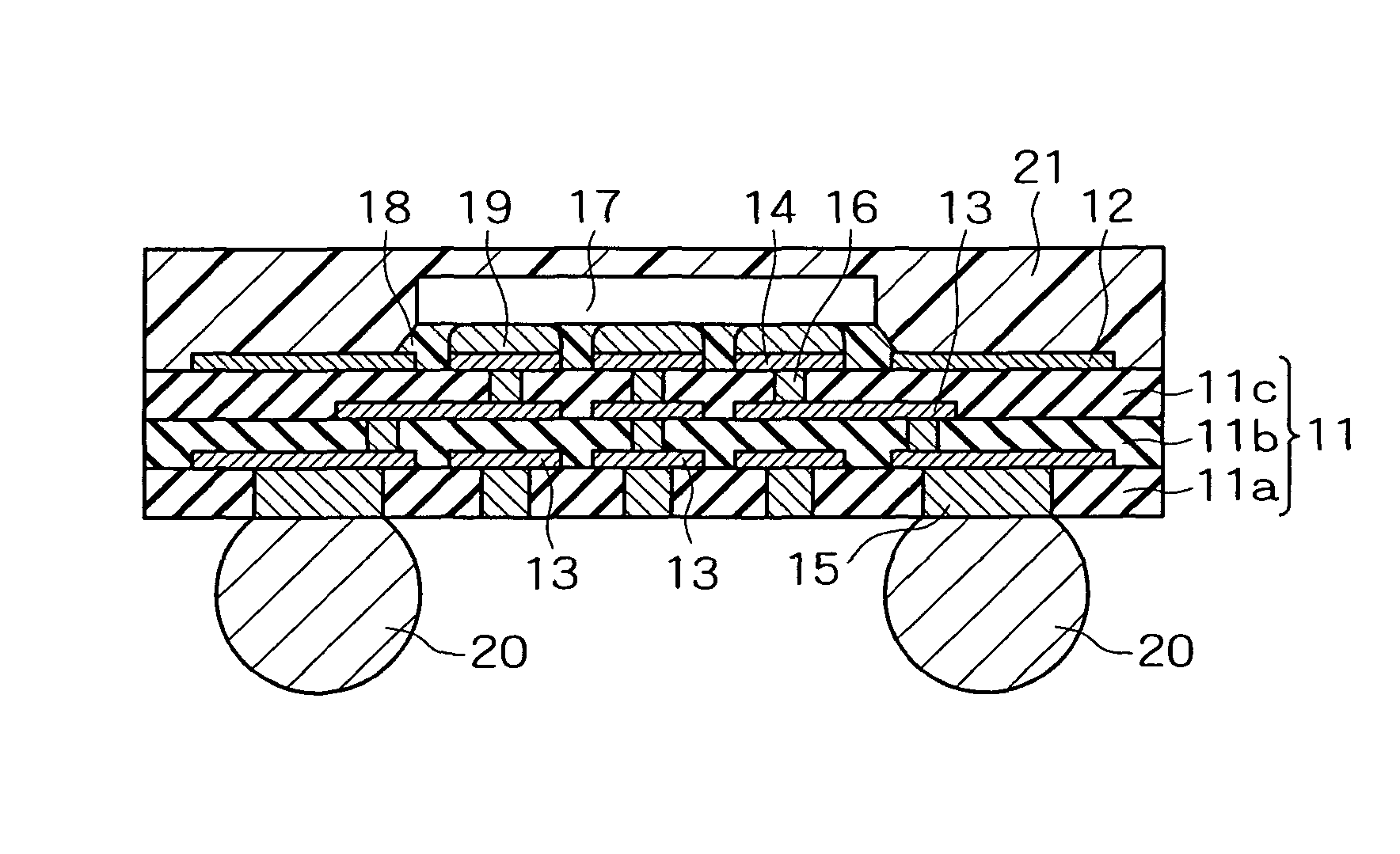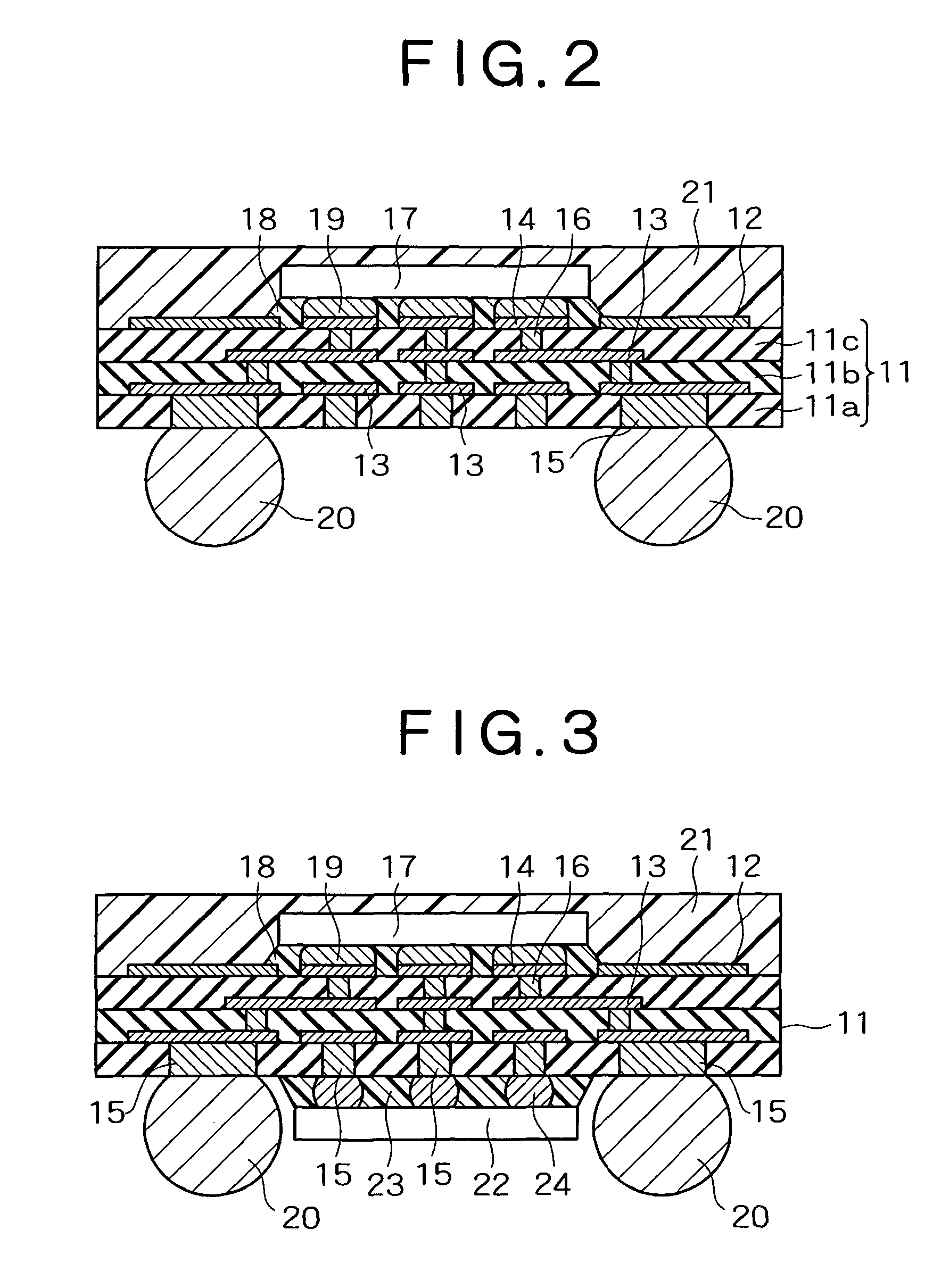Multilayered wiring board, semiconductor device in which multilayered wiring board is used, and method for manufacturing the same
a multi-layer wiring and semiconductor technology, applied in the direction of printed circuit parts, printed circuit non-printed electric components association, printed circuit incorporation, etc., can solve the problems of board thickness, inability to meet the recent demand for higher density, and thick through-holes of boards, so as to reduce the risk of electrical peeling during heating, reduce the risk of electrical peeling, and reduce the effect of signal degradation during transmission
- Summary
- Abstract
- Description
- Claims
- Application Information
AI Technical Summary
Benefits of technology
Problems solved by technology
Method used
Image
Examples
first embodiment
[0039]FIG. 1 is a local sectional view showing the multilayered wiring board according to the present invention. The multilayered wiring board shown in FIG. 1 has second electrodes 15 embedded in the bottommost insulation layer 11a. A second wiring layer 13 is formed on the insulation layer 11a and second electrodes 15, and an intermediate insulation layer 11b is formed so as to cover the insulation layer 11a and second electrodes 15, including the second wiring layer 13. Also, one or a plurality of pairs of the second wiring layer 13 and intermediate insulation layer 11b is disposed (a single pair in the diagram). The second wiring layer 13 is formed on the topmost (a single layer in the diagram) intermediate insulation layer 11b, and a topmost insulation layer 11c is formed so as to cover the intermediate insulation layer 11b, including the second wiring layer 13. First electrodes 14 and a first wiring layer 12 are formed on the topmost insulation layer 11c. Vias 16 provide electr...
second embodiment
[0052]FIG. 2 is a cross-sectional view showing the semiconductor device according to the present invention, and the wiring board shown FIG. 1 is used therein. In the FIG. 2, the second electrodes 15 disposed in the bottommost insulation layer 11a shown in FIG. 1 are shown as connected only to the solder balls 20. Accordingly, in FIG. 2, the same reference numerals are used for the same constituent elements as FIG. 1, and a detailed description of the multilayered wiring board shown in FIG. 1 is omitted.
[0053]The semiconductor device shown in FIG. 2 has a semiconductor element 17 mounted on the first electrodes 14 of the topmost insulation layer 11c of the multilayered wiring board shown in FIG. 1. The diagram shows only a single semiconductor element 17, but a plurality of semiconductor elements may be mounted, and capacitors, resistors, and other components may also be mounted.
[0054]The semiconductor element 17 is configured so that electrodes (not shown) on the surface of the semi...
fifth embodiment
[0081]FIG. 6A corresponds to the step shown in FIG. 5C in the method for manufacturing a semiconductor device of the fifth embodiment, and shows the step prior to removing the support board 25. The steps preceding the step shown in FIG. 5C are the same as the steps shown in FIGS. 4 and 5. Washing and heating treatments are suitably carried out between each step.
[0082]First, the second electrodes 15, insulation layer 11, first wiring layer 12, second wiring layer 13, and first electrodes 14 are formed on the support board 25, as shown in FIG. 6A. In the present invention, an insulation layer 11a is provided by forming a photosensitive polyimide resin to a thickness of 7 μm on a support board 25 in which a release layer (not shown) and an electroconductive seed metal layer (not shown) are sequentially disposed on a silicon wafer that has a thickness of 0.725 mm and a diameter of 8 inches (200 mm) and that is provided with a thermal oxidation layer. The second electrodes 15 are formed ...
PUM
| Property | Measurement | Unit |
|---|---|---|
| diameter | aaaaa | aaaaa |
| thickness | aaaaa | aaaaa |
| peel strength | aaaaa | aaaaa |
Abstract
Description
Claims
Application Information
 Login to View More
Login to View More - R&D
- Intellectual Property
- Life Sciences
- Materials
- Tech Scout
- Unparalleled Data Quality
- Higher Quality Content
- 60% Fewer Hallucinations
Browse by: Latest US Patents, China's latest patents, Technical Efficacy Thesaurus, Application Domain, Technology Topic, Popular Technical Reports.
© 2025 PatSnap. All rights reserved.Legal|Privacy policy|Modern Slavery Act Transparency Statement|Sitemap|About US| Contact US: help@patsnap.com



